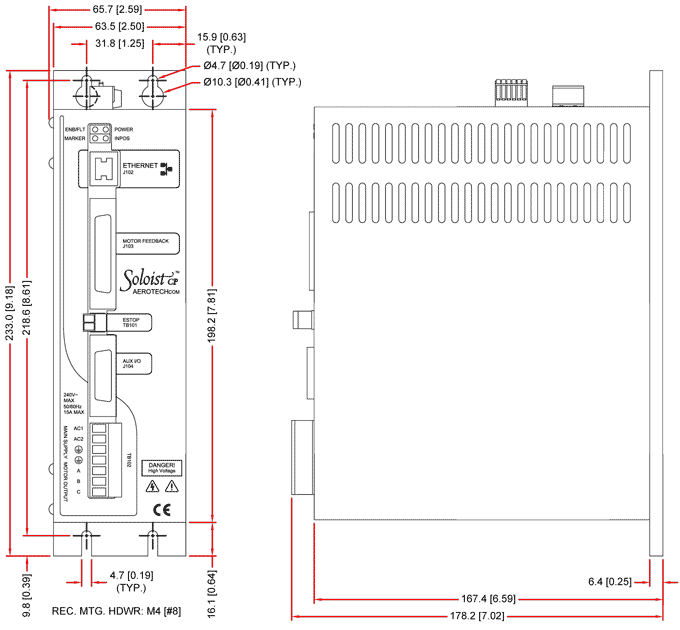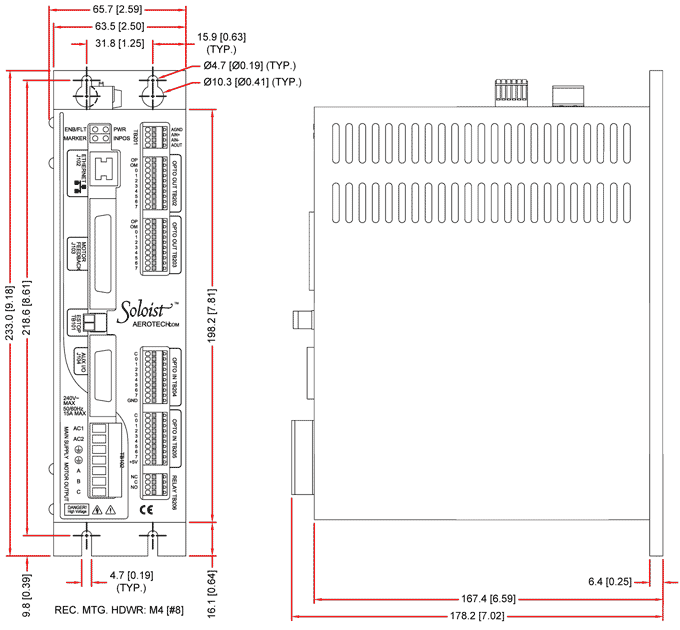Specifications
Soloist CP Specifications
| Soloist CP | Units | 10 | 20 | 30 |
|---|---|---|---|---|
| Motor Style | Brush, Brushless, Stepper(1) | |||
| Motor Supply | VAC | SinglePhase 7-240 V; 50/60 Hz | ||
| Control Supply(2) | VAC | 85-240 VAC; 50/60 Hz | ||
| Bus Voltage(3) | VDC | 10-320(3) | ||
| Peak Output Current (1 sec)(4) | Apk | 10 | 20 | 30 |
| Continuous Output Current(4) | Apk | 5 | 10 | 10 |
| Digital Inputs | 6 Optically Isolated (2 High Speed) | |||
| Digital Outputs | 4 Optically Isolated | |||
| Analog Inputs | One 16-bit Differential; ±10 V | |||
| Analog Outputs | One 16-bit Single-Ended; ±10 V | |||
| Dedicated Axis I/O on Feedback Connector | Three Limit Inputs (CW, CCW, Home); Three Hall Effect Inputs (A, B, C); Three High-Speed differential Inputs (sin, cos, mkr for encoder); Motor Over-Temperature Input | |||
| Dedicated I/O on Auxiliary Feedback Connector | sin, cos, mkr for Aux Enc; Aux Enc can be used for PSO Output | |||
| I/O Expansion Board(5) | 16/16 Digital Opto-Isolated; 1 Analog In (±10 V, 12-bit Differential); 1 Analog Out (±10 V, 16-bit) | |||
| High Speed Data Capture | Yes (50 ns Latency) | |||
| Automatic Brake Control | Standard; 24 V at 1 A | |||
| Emergency Stop Sense Input (ESTOP)(6) | Standard; 24 V Opto-Isolated | |||
| Position Synchronized Output (PSO) | Single Only | |||
| Can Output Multiplied Encoder | No | |||
| Can Output Square Wave Encoder | Yes | |||
| Primary Encoder Input Frequency | 200 kHz Amplified Sine Wave Standard (for onboard multiplier); 40 MHz TTL Square Wave | |||
| Secondary Encoder Input Frequency | 32 MHz Square Wave | |||
| Encoder Multiplication | Up to x4096 (MXU) | |||
| Absolute Encoder | Renishaw Resolute BiSS; EnDat 2.1; EnDat 2.2 | |||
| Resolver Interface | N/A | |||
| Internal Shunt Resistor | 40 W Continuous; 400 W Peak (5 seconds) | |||
| External Shunt | Optional | |||
| Ethernet | Yes | |||
| USB | Yes | |||
| RS-232 | Yes | |||
| FireWire | No | |||
| Fieldbus | Modbus TCP; Ethernet/IP | |||
| Current Loop Update Rate | kHz | 20 | ||
| Servo Loop Update Rate | kHz | 1 to 20 | ||
| Power Amplifier Bandwidth | kHz | Selectable Through Software | ||
| Minimum Load Inductance | mH | 0.1 @ 160 VDC (1.0 mH @ 320 VDC) | ||
| Operating Temperature | °C | 0 to 50 | ||
| Storage Temperature | °C | -30 to 85 | ||
| Weight | kg (lb) | 1.64 (3.6) | ||
| Standards | CE approved, NRTL safety certification, 2011/65/EU RoHS 2 Directive | |||
For stepper motors only, one-half of bus voltage is applied across the motor (e.g., 80 VDC supply results in 40 VDC across stepper motor).
"Keep Alive" supply.
Output voltage dependent upon input voltage.
Peak value of the sine wave; rms current for AC motors is 0.707 * A pk.
Requires I/O option.
Requires external relay to remove motor supply power.

Dimensions
Soloist CP  Enlarge Image
Enlarge ImageSoloist CP with additional I/O  Enlarge Image
Enlarge Image